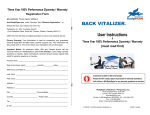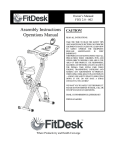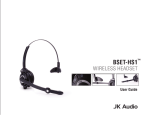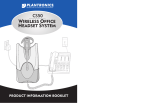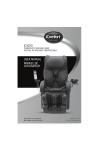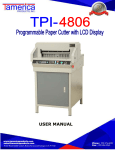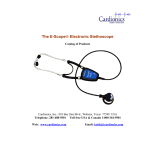Download PA-1779T Instruction Manual
Transcript
PA-1779T Independence Series Owner’s Manual “Our Premier ANR Headset” We believe our PA-1779T is the quietest ANR available. Our technology and comparison testing show it to be an unbeatable value. It contains more features than any other ANR headset currently available. The PA-1779T is the only self-contained ANR aviation headset manufactured in the world. It features a rechargeable NiMH battery in the ear cup providing power for the ANR function, negating the need for a battery box or additional cords that most other ANR headsets require. This exceptional unit has a passive noise attenuation of 25 dB. It takes advantage of closer tolerance mil-spec components for a more stable and efficient performance. The PA-1779T adds an additional 18-22 dB active noise reduction at 100 Hz. Also available is a panel mounted version. A slightly modified version of this unit has been in use on the International Space Station for over five years and has been certified by NASA and the U.S. Department of Defense. A sheepskin head pad makes the PA-1779T very comfortable and breathable, virtually eliminating hot spots. The silicone gel ear seals rest easily against your ears providing more comfort and noise attenuation than any other type of seal. The 14.5 oz weight is one of the lightest muff style ANR headsets manufactured today. Features Passive: 25 dB Active: Additional 20 – 22 dB Auto Shut-Off Cell / Satellite Phone Interface Mono / Stereo Capability Silicone Gel Ear Seals Genuine Sheepskin Head Pad Adjustable “Memory” Flexible Microphone Boom Auxiliary Audio Interface: Music, Checklists, Warnings Made in USA 1 Custom Padded Protective Case Rechargeable NiMH Battery Noise Canceling Electret Microphone Foam Mic Windscreen Cover Dual Volume Control Totally Self-Contained ANR Unit ANR Usage Time: 45 – 50 hours Weight: 14.5 ounces Five-Year Warranty Additional Models PA-1779TP PA-1779TB PA-1779TH Panel Plug Version Bose® (6 pin) Plug Version Helicopter Plug Version Optional Accessories 220V Wall Charger DC to DC Quick Charger Standard Foam Ear Seals (PA-21F) Metal Headband Throat Microphone (PA-2E) Leatherette Windscreen Cover (PA-11) Table of Contents Introduction Features Additional Models Optional Accessories Fitting Your Headset Enhanced Voice Intelligibility (EVI) Microphone Placement Volume Control Mono / Stereo Selector Switch LED on Ear Cup Microphone, Audio/Audible Checklist and Charging Jack (Boom Side Ear Cup) Rechargeable NiMH Battery, Power Jack, and Wall Charger Modular Flexible Design – Comm-Cord & Microphone Boom Auto On/Off Shut-Off Testing ANR Function Cell/Satellite Phone Capability Sheepskin Head Pad Silicone Gel Ear Seals Taking Care of Your Headset Custom Padded Carrying Case Microphone Windscreen Ear Cushions Communication Cord Technical Specifications A. Microphone B. Transducers C. Enhanced Voice Intelligibility D. Rechargeable Nickel Metal Hydride Battery Contact Information 2 1.0 1.1 2.0 2.0 3.0 3.1 3.2 3.3 3.4 3.5 3.6 3.7 4.0 4.1 4.2 4.3 4.4 4.5 5.0 5.1 5.2 5.3 5.4 5.5 5.5 6.0 6.1 6.2 6.3 3.0 Fitting Your Headset Wearing your headset properly is paramount in achieving both comfort and the best performance possible. The headset should be placed on your head and slowly pulled down so that each ear cup is properly positioned over the ears. It should apply slight pressure on your head without being to snug. You may need to make your final adjustments in a high noise environment and with the ANR electronics turned on. 3.1 Enhanced Voice Intelligibility (EVI) The Independence headset has incorporated into its integrated circuitry a proprietary DSP circuit which enhances all audio within speech frequencies. The result is a more intelligible incoming ATC transmission. Incoming speech frequencies are amplified 2 – 4 dB for more clarity and intelligibility. This is particular favorable for pilots who may have some hearing loss. 3.2 Microphone Placement Your headset comes with an adjustable “memory” flex microphone boom and a noise canceling electret microphone. The mic boom can be rotated 180 degrees for left or right side use. Proper placement of the microphone is critical in order to achieve clear communications. The microphone should be positioned at the corner of your mouth approximately ¼” away from your lips. 3.3 Volume Control (On Comm-Cord Splitter) The PA-1779T is fitted with two individual volume controls, one each for the right and left side of the headsets. The volume control is located on one side of the triangular splitter on the comm-cord. The other side contains the mono-selector switch. When adjusting the volume control the pilot-in-command should adjust their volume control first with the audio system turned on and the ANR system turned off. Then turn the ANR back on and adjust the individual sides of the headset. 3.4 Mono/Stereo Selector (On Comm-Cord Splitter) Your headset comes standard with a Mono/Stereo selector switch which is located on one side of the triangular splitter. “M” indicates the mono position while “S” indicates the stereo position. The volume control is on the reverse side. It should be noted that if you are using a monaural intercom and your headset is set in the stereo position, you will only hear through one speaker of your headset. With a stereo intercom you will hear true stereo in both ears. 3.5 LED Light On Ear Cup (Left Shoulder of Boom Side Ear Cup) If illuminated, the light indicates the ANR system is activated. 3.6 Microphone, Audio and Charging Jack (Boom Side Ear Cup) There are two jacks on the boom side ear cup. The smaller of the two jacks is for the microphone plug or can be used for the wall charger. The larger jack which is directly beneath the smaller jack is used for cell phone or auxiliary audio/audible checklist. 3.7 Rechargeable NiMH Battery, Power Jack and Wall Charger Your PA-1779T ANR headset has a rechargeable nickel metal hydride battery pack installed inside the ear cup. This type of battery has no “memory effect” as with other rechargeable batteries such as NiCad. There are two 3.5 mm jacks for charging the battery with the provide wall charger. They are located on each ear cup directly below the overhead cord where it enters the cup. These jacks serve a dual purpose and can also be used to plug in the microphone. 3 4.0 Modular Flexible Design – Comm-Cord & Microphone Boom The PA-1779T’s modularity includes some unique features. We have designed the headset to be modular with the introduction of a detachable comm-cord and microphone boom. This modularity makes the headset “field repairable”. Pilots can use the headset with or without comm-cord when they are doing their preflight check. They can have different comm-cords for different uses such as helicopter or with 2-way radios, simply by purchasing the appropriate comm-cord. Industrial users can wear a modified version with or without a microphone and protect their hearing as well as have the flexibility to walk around without worrying about a power source. The user can adjust the microphone boom from left to right by plugging into the 3.5 mm jack (small washer) on either side of the left or right ear cup. The larger jack (large washer) located under the smaller jack on the boom side of the headset is reserved for plugging in your cell phone or music input source (IPOD® MP3® or CD player). The microphone boom can be totally removed by fully extending the headband to its largest size so approximately only 3/4 ” of the headband is passing through the rubber bushing located in the center of the ear cup. Then grasp the tip of the headband and slowly pull/twist the headband through the rubber bushing. To reattach, line up the molded rubber pieces of headband and snap the rubber molded piece back onto the pivot. 4.1 Auto Shut-Off Circuitry Your new PA-1779T comes equipped with our new Auto Shut-Off proprietary circuitry. The ANR will shut-off automatically when the unit is unplugged from the aircraft or the master avionics switch is turned off. This will conserve your battery’s life. The headset will automatically turn on when the unit is plugged into a live intercom system when the white On/Off button is in the “On” position. Should you want to turn off the headset while you are using the unit in an aircraft, simply press the On/Off button. If you would like to bypass the Auto Shut-Off feature and use the headset as an ANR hearing protector, there is an accessory available – the ANR/Cell Phone Energizer Plug. It can be purchased direct from Pilot Communications USA at 1-888-GO-PILOT or www.pilot-usa.com 4.2 Testing Your ANR System In order to test your ANR headset, it must be plugged into the aircraft with a live intercom with the white On/Off button in the “On” position. The LED light will become illuminated when the ANR system is on. This will let you properly test all functions of the ANR system. If you are not plugged into a live intercom or the white On/Off button is in the “Off” position, the ANR system will not be activated but the headset will work as a passive headset. 4.3 Cell/Satellite Phone Capability Located on the boom side ear cup there are two 3.5 mm jacks. The upper jack is used for the microphone cord and can also be used for charging the headset. The lower jack which has a larger nut around the jack, is for cell phone or audio input. The headset comes with two cables marked “PHONE” and “AUDIO”. The right angle (90o) plug on both cables should always plug into the headset. The straight plug will plug directly into your cell phone or audio input source. 4.4 Sheepskin Head Pad The headset is fitted with a breathable sheepskin head pad. This head pad virtually eliminates all complaints of hot spots caused by non-breathable synthetic head pads used by other manufacturers. The natural head pad combined with the single suspension of the headband assures a comfortable fit. 4.5 Silicone Gel Ear Seals Your headset is fitted with our proprietary silicone gel ear seals. The new design eliminates 30% of the weight of normal silicone ear seals and provides superior noise attenuation. 4 5.0 Taking Care Of Your Headset Treat your headset like you would treat your stereo and computer at home. To insure the full life of your headset, keep it clean and free of dirt. This will extend your headset’s life and give you many years of flying confidence. Clean your headsets with non-alcohol wipes or a soft cloth, slightly dampened with water and a mild soap. Never use alcohol. Plastic parts dry out or fray when exposed to alcohol based products. Headband, ear cups, ear seals and cords can be lightly cleaned but one should be careful around the microphone and speakers on the headset. 5.1 Custom Padded Carrying Case A padded case is provided with your PA-1779T. The case will protect your headset when stored properly and provides a central place to keep your wall charger, comm- cord, cell phone and auxiliary audio cord. 5.2 Microphone Windscreen Pilot Communications USA recommends periodically replacing the microphone windscreen if necessary. The foam microphone windscreen helps eliminate the popping “P”s and “T”s and annoying breath puffs when you’re communicating with the headset. The foam microphone windscreen also helps protect the microphone from moisture and other elements that may cause damage to the electronics. You may use mild soap and water to clean your foam windscreen. Place the foam windscreen in mild soapy water. Rinse and make sure the windscreen is fully air dried before reattaching to the microphone. 5.3 Ear Cushions Ear seals also need periodic replacing. Usage and temperature variations are two factors that will influence the life span of your ear seals. We have several types of seals on our headsets. Generally, PVC, foam and silicone gel style ear seals can be wiped off with mild soap and water. Do not submerge the ear seals in water. All three types of seals have vent holes and water would enter the vent holes and ruin the ear seal. 5.4 Communication Cord Take care of your communication cord. Wires in the cord can break if abused. Always disconnect them by disconnecting the plugs, not by pulling the cords. Pulling on the cord, instead of the plugs is a major cause of headset repairs, causing breaks and static. We recommend storing your headset in a headset case or flight bag and keeping the cords free of obstruction to reduce wear and tear on your headset. Technical Specifications 5.5 Microphone Generating Element: Condenser – Noise Canceling Polar Pattern: Bi-Directional Frequency Response: 150 – 4000 Hz Impedance: 50 Ohms @ 16VDC Sensitivity: 100 dB @ 1mW Input Power Requirements: 8 – 16 VDC Current Drain: 8 mA at 8 VDC Color/Case Materials: Black ABS Weight: 6 grams Mating Connector: U-173/U 5 6.0 Transducers Audio Speaker Impedance: 300 Ohm Military: 19 Ohm Nominal Power: 100 mW Max Power: 200 mW SPL: 106 + 2dB at 1 KHz Effective Frequency Range: 200 Hz – 20,000 Hz Effective DNC Frequency Range: 30 Hz – 8000 Hz Active Noise Reduction: 20 – 22 dB at 100 Hz Maximum Ambient Noise Level: 120 dB SPL 6.1 Enhanced Voice Intelligibility (EVI) Circuit 2 – 4 dB Gain at 500 – 1000 Hz when DNC is ON Signal Noise Ratio: Less than 58 dB 6.2 Nickel Metal Hydride Battery 8.4V 720 mAH Battery Charger: 100V Input 10.15 VDC 90mA 200V Input 10.15 VDC 90mA Charge Time: @12 – 16 Hours Usage Time: @ 45 – 50 Hours Continuous Usage Depending On Noise Level Battery Life: @1000 Charges or @ 5000 Hours Total Usage Auto Shut-Off Timer: Between 15 and 30 Seconds Auto Shut-Off will take place and the LED light will dim as power to the ANR System is turned off. Pilot Communications USA 70 Maxwell Irvine, CA 92618 Toll Free: 1-888-GO-PILOT Tel: 949-748-8880 Fax: 949-748-8881 www.pilot-usa.com [email protected] 6








